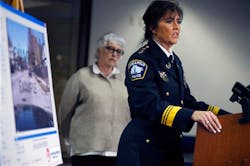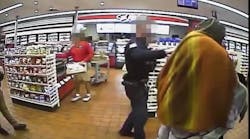Minneapolis Police Chief Janee Harteau confirmed Wednesday, May 15, that an officer involved in a fatal squad car collision last week had gone through a red light and had yet to give a statement.
The officer, responding to a Friday incident in South Minneapolis in which two other officers were wounded and a burglary suspect was fatally shot, collided with motorcyclist Ivan Romero Oliveres, 24, and his passenger, Joselin Torrejon-Villamil, 20. Torrejon-Villamil was hospitalized.
The collision, at West 26th Street and Blaisdell Avenue South, occurred more than a half-hour after suspect Terrance Franklin, 22, died of multiple gunshot wounds in a struggle with police nine blocks away.
A police supervisor at the scene of the shooting -- a house in the 2700 block of Bryant Avenue South where Franklin was found after a break-in -- had requested more officers to help secure the area, Harteau said.
She noted that the officer involved in the collision had the vehicle's lights and sirens on and, according to squad video and GPS data, slowed to 16-17 mph before entering the intersection, which lacks a device that allows police to change traffic lights upon approach.
According to state law, officers responding to emergencies "shall slow down as necessary for safety, but may proceed cautiously past such red or stop sign or signal after sounding siren and displaying red lights."
Harteau said Romero's motorcycle struck the squad's rear wheel well and that the speed
of the cycle at the time of the collision was still under investigation. The accident reconstruction was being turned over to the Minnesota State Patrol "as an additional check," she said.
So far, Harteau said, her efforts to reach out to the families of Franklin and Romero have gone unanswered.
"There's certainly not a lot I can tell them but what I can, I will," Harteau said. "I would first like to say that I'm sorry for their loss. Regardless of the situation, they've lost a family member."
Franklin's family said Wednesday that the reason for their not contacting Harteau at this point was simple: They want to see his body first.
"My mom is not ready to talk, she doesn't have the autopsy, the body. She needs to see him. Then she'll be ready to talk," said Franklin's sister, Jasmine Mitchell, adding, "We're very confused about what happened."
"I'm aware that they haven't (seen the body)," Harteau said, "and we've told them to contact the (medical examiner). We have no control over Mr. Franklin's body."
Mitchell said the family had asked to see the body but was told by authorities that it was part of an investigation and could not be released. She said she wasn't sure whether the police or medical examiner told her that.
Harteau released no other information about either of the incidents -- including whether Franklin was armed.
"At some point during the altercation the suspect (Franklin) tried to gain control of an officer's firearm, which is an MP5" submachine gun, a Saturday police statement said. "Shots were fired during the struggle. Exactly who fired and how many times has not yet been determined."
Franklin's girlfriend -- who was with him in a car when he fled police Friday -- told the Pioneer Press on Friday that he was carrying a gun.
Harteau also said that the officer involved in the collision and officers Michael Meath and Ricardo Muro -- both shot in the legs -- had yet to give statements.
Harteau noted that Meath and Muro were still recovering and on medication, and she wanted them to be lucid while giving statements. Harteau added that no officers had refused to give a statement.
As for the officer involved in the collision, "He has been through quite an ordeal and is visibly shaken. We want to make sure that we give him the time he needs to be able to give us a statement.
"We also have video that is much better than his recollection," she added. "That's scientific."
Eugene O'Donnell, a lecturer at the John Jay College of Criminal Justice in New York, noted that the potential for criminal charges against officers often has to be ruled out before they can be compelled to give statements.
"They could theoretically invoke Miranda rights," said O'Donnell, who served as both an officer and assistant prosecutor in New York.
O'Donnell added that officers often have protections in their labor contracts.
John Delmonico, president of the Minneapolis police union, could not be reached for comment Wednesday evening.
Copyright 2013 - Pioneer Press, St. Paul, Minn.
McClatchy-Tribune News Service



